Here are some helpful pointers for technicians for any issues they may have with water pump failure.
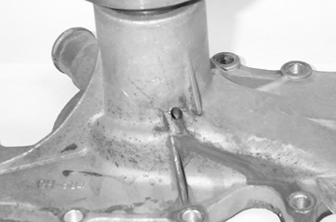 1. Failure Symptom: Seal Leakage-Dirty System
1. Failure Symptom: Seal Leakage-Dirty System
Evidence of seal leakage from weep hole (Figure 1) – This pump has been in service only a short time before rusty-looking coolant began to leak out of the weep hole, leaving behind large deposits of rust and calcium. Figure 1 shows a buildup of rust particles with a mud-like consistency within the pump.
Cause of Failure: Cooling System Contamination
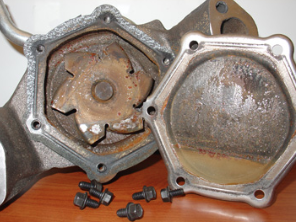 The abrasiveness of the particles found in a badly contaminated system will prematurely wear the water pump seal (Figure 2). Harmful contamination is common in systems that are not properly maintained. A system that is not properly pressurized will allow air to enter and promote the build-up of rust. If water with a high mineral content is added to the system and is heated, it will begin to form deposits that will accumulate and cause passage restrictions, which may damage the seal.
The abrasiveness of the particles found in a badly contaminated system will prematurely wear the water pump seal (Figure 2). Harmful contamination is common in systems that are not properly maintained. A system that is not properly pressurized will allow air to enter and promote the build-up of rust. If water with a high mineral content is added to the system and is heated, it will begin to form deposits that will accumulate and cause passage restrictions, which may damage the seal.
Remedy: Thoroughly flush a contaminated system BEFORE replacing the water pump. Check system pressure, use correct coolant mixture, and consider using distilled water where locally deemed necessary.
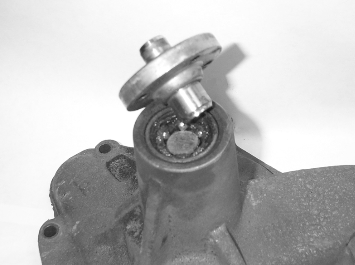 2. Failure Symptom: Shaft Breakage
2. Failure Symptom: Shaft Breakage
A break usually occurs through the front bearing race portion of the shaft. This particular break can be noted by a clean fracture, rather than blue heat discoloration, which can appear in this same type of failure (Figure 3).
Cause of Failure: Bearing Overload
This bearing failed as the result of a sudden overload caused by vibration or imbalance. The lack of heat-related discoloration indicates that this was sudden rather than gradual, and was probably compounded by rapid engine acceleration. Blue discoloration of the shaft would indicate that there was excessive heat build-up for some period prior to shaft breakage. This heat build-up can be caused by the tremendous centrifugal forces created by imbalance. This overloads the bearing generating a great deal of heat. This load is amplified through rapid acceleration and high RPM operation.
Remedy: Carefully check alignment of all pulleys. Also check the pulleys for straightness or fatigue. Install belts using a belt tension gauge according to manufacturer’s recommendations. Carefully inspect fan/fan clutch assembly for a bent or damaged fan, a worn spacer, or a worn or damaged fan clutch. Be sure to evenly tighten the mounting bolts to manufacturer’s specifications.
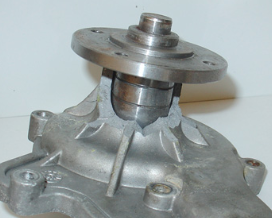 3. Failure Symptom: Casting Breakage
3. Failure Symptom: Casting Breakage
This breakage will normally occur around the bearing support (Figure 4).
Cause of Failure: Excessive Vibration
Casting failure is normally associated with heavy vibration or imbalance which can be caused by a badly worn fan clutch or bent fan.
Remedy: Carefully inspect pulley, belt alignment and fan/fan clutch assembly, replacing any bent or worn components.
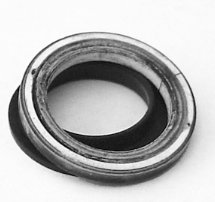 4. Failure Symptom: Seal Leakage-Clean System
4. Failure Symptom: Seal Leakage-Clean System
Leakage was observed from this pump, which had just recently been installed in a fairly clean cooling system (Figure 5).
Cause of Failure: Thermal Shock
The seal was more closely inspected after no signs of contamination were observed. This revealed that the seal damage had come from thermal shock, typically caused by adding cold coolant to an overheated engine. The damage appears as a diametrical crack across either the seal face or the mating ring. This can also occur following water pump replacement if the engine is started before adding coolant.
Remedy: Take proper precautions when filling your radiator, especially when the engine may be very hot. Allow an overheated engine to sit and cool before adding coolant. Then, restart engine and allow it to run while slowly adding the remainder. NEVER start the engine without coolant.
Source: ASC Industries




